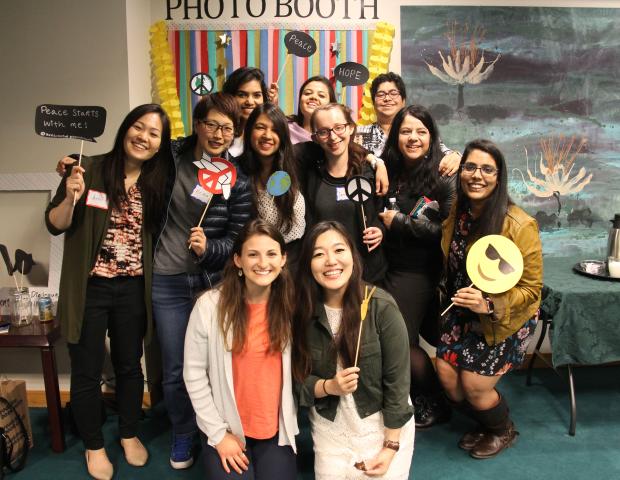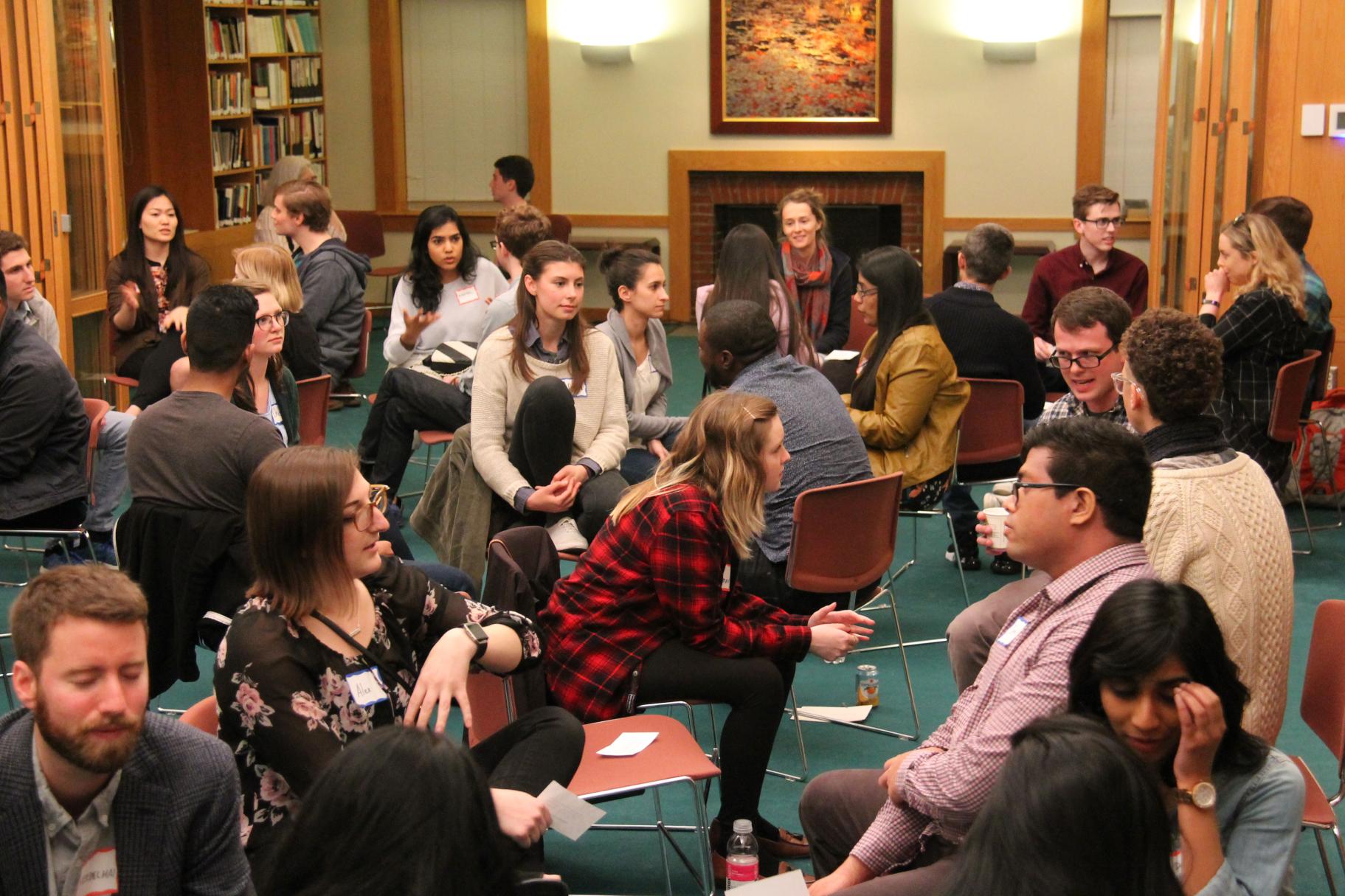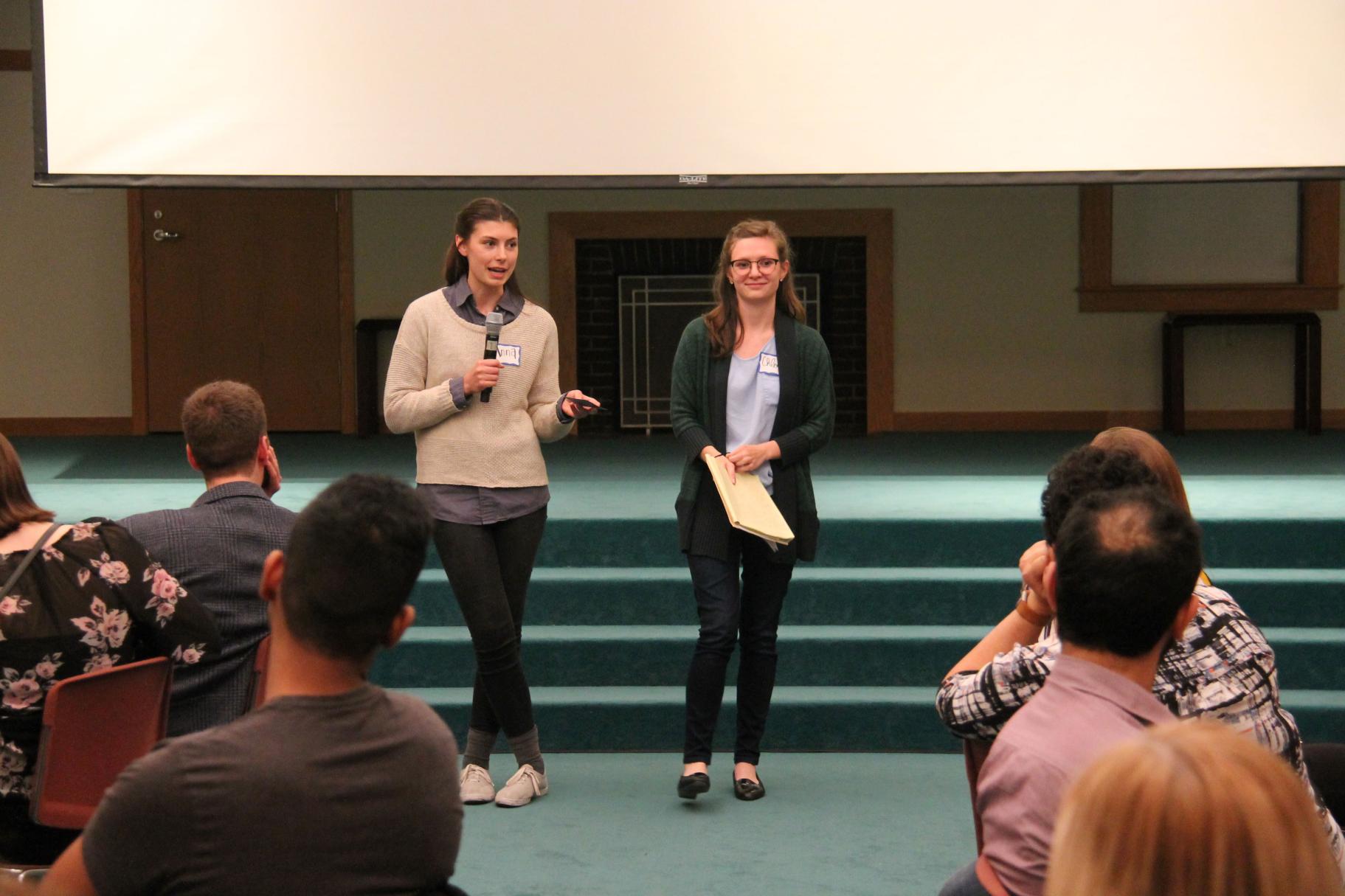Dialogue Nights #6: The Apathy Epidemic
Dialogue Nights participants at the photo booth
The enthusiasm evident at the Ikeda Center’s third Dialogue Nights event of 2018, held on May 18, belied the evening’s organizing topic: “The Apathy Epidemic.” Instead, the energetic presence of more than forty Boston-area university students and young professionals modeled a compelling answer to the evening’s subtheme, which asked: “What Is the Cure?”
The energy was partly the result of the gathering being a collaboration between the Ikeda Center and Massachusetts Peace Action (MAPA) Next Gen, a group of young Bostonians working to engage society in new modes of peace building. Their goal is both to learn from well-established peace organizations and to bring fresh perspectives to their efforts. The energy was also a product of idealistic and committed young people finding themselves in the presence of so many like-minded peers.
In her welcoming remarks, Ikeda Center Program Manager Lillian I highlighted elements of Daisaku Ikeda’s peacebuilding philosophy that have inspired the Dialogue Nights series. A core focus of Mr. Ikeda’s peace activities, said Lillian,
is his deep trust and belief in young people as agents of change who have the right and might to build the world we want to live in. Inspired by Mr. Ikeda, we started this Dialogue Nights series last fall, with the hope to bring young people together to discuss and tackle the issues that concern us and through dialogue open a way forward together.
Lillian said that while researching this month’s theme, the program team came across an article at HuffPost that made several points about apathy that resonate with Ikeda’s view. In the article, author Natasha Puri explained how, when confronted with horrific events, “our body uses apathy to make the irregular regular, or to cope with distress that appears impossible to solve.” The first step toward defeating apathy, said Puri, is “to focus on increasing awareness—not telling the world what, but explaining why, and discussing how.” Lillian said that like Puri, she and the Ikeda Center believe youth engagement can “truly revolutionize the world” and that as youth “we should strive to actively champion change, demonstrate compassion, and transform the way we look at problems to solve them in a way never done before.”
Causes and Cures
After some icebreaking activities, Lillian provided context for this particular Dialogue Nights gathering. First she noted that Mr. Ikeda, having seen first-hand the destruction of post-war Japan, has made nuclear weapons abolition a core commitment, one he hasn’t deviated from for many decades now. His thinking on nuclear abolition is prominent in his yearly published peace proposals. “For Mr. Ikeda,” said Lillian, “nuclear weapons represent the ultimate threat to our right to live.”
Next, she explained how the Ikeda Center has been striving for the last several months to galvanize and motivate young people in pursuit of nuclear weapons abolition. Working with peace educators Betty Reardon and Zeena Zakharia, the Center held a series of seminars engaging local university students in a process of learning about and taking action toward abolition. Through this process, said Lillian, “we saw students go from being completely disengaged around the issue of nuclear abolition to becoming these amazing protagonists and champions of the issue.”
One of the main products of the seminar process was a video produced by the students to uncover how Bostonians feel about the threat of nuclear weapons and prospects for nuclear abolition. Two of the student producers of the video—Lizzy Buechel and Catrina Whitman, both of Northeastern University—introduced a viewing of it by talking about how their participation in the seminar series transformed them.
Catrina talked about how her involvement with the seminars changed her initial feeling that the nuclear threat was just too distant, and therefore not urgent, to her present conviction that nuclear abolition is in fact an urgent challenge. Further, in her view, the general lack of public attention to the matter doesn’t negate the reality that the nuclear threat “would affect absolutely everyone.”
Lizzy shared how she entered the process with doubts about whether she could trust her voice on this issue, especially since she “seemed so alone” in her concerns over the nuclear threat. However, her confidence grew as she engaged with so many passionate individuals during the seminar process. And she shared how it was her own increasing passion for the cause that enabled her to break through with a roommate who had previously been unswayed by Lizzy’s entreaties on the topic.
Introducing the video, Catrina said that her main takeaway was that “asking the right questions” is the best way to raise awareness and engage people, especially apathetic ones, on the topic of nuclear abolition. This technique can be used to motivate people in relation to any issue they might see as distant—i.e., the kind that causes them to “glaze over” and chalk up a given issue as “someone else’s problem.” With that, Catrina said, “I hope you enjoy this video and that it inspires you to get out there and advocate for something you believe in.”
After viewing the video, participants broke into small groups to discuss three questions:
- What are some issues you have become indifferent to? Why do you feel we have become apathetic towards these issues such as nuclear weapons, violence, and poverty, etc.? Have you always felt this way?
- Why do you feel our generation is apathetic about peace but not movements around social justice?
- If apathy is the diagnosis, what’s the prescription? How can we move from apathy to action?
Group One. As a case in point, the first group to report noted that the horrific school shooting in Santa Fe, Texas, that had happened earlier in the day mostly seemed to elicit a shrug, an “Oh, that’s too bad” response. However, in the past “the world would have stopped.” Have we become that numb?, they wondered. They also talked about how their generation can be overly focused on their “social cliques.” Then there is the default reaction that peace is an overly Utopian idea that youth usually write off as “hippy dippy.”
Group Two talked about “the cure in tandem with the cause.” Specifically they discussed “how most of us don’t know what has already been achieved in terms of nuclear disarmament and [how that] that leads into a broader problem of us feeling super helpless and jaded.” The cure is talking about what has been achieved.
Group Three. This group wondered about “analogies” between how apathy manifests in relation to challenges such as nuclear war and war in general, on the one hand, and poverty on the other. “There’s a really clear analogy with poverty,” the group three speaker said, for example in how people react when they encounter “homeless people begging everyday.” Why do people not act to help? Maybe you think these people “can sustain themselves,” or maybe you’ve been “taught not to give money to them,” or maybe it just “feels overwhelming.” It seems like all our challenges produce these same type of responses, with inaction resulting, concluded the speaker.
Next, the groups reported on their “cures,” evincing considerable wisdom in the process. Ideas included:
- “Faith it” until you make it, a tweaking of the maxim, “Fake it until you make it.” The idea is to overcome early doubts and take action with the faith that at some point you will see you have made a positive difference.
- Sensitize people to issues, but do so in a way that empowers and encourages, rather than disempowers and discourages. Appeal to people’s hearts, and help them achieve a “change in their perception of human life.”
- Focus on small, achievable steps as a way to negate concerns that our challenges are so vast and numerous that an individual or a small group of individuals can’t make a difference. Focusing initially on full nuclear abolition can be intimidating.
- Share the very real good news that is central to any struggle for justice or peace. Some examples: A million people rallied for nuclear abolition in Central Park in 1982. And just last year, “the nations of the Global South—African countries, Latin American countries, Southeast Asian countries, Pacific Island countries—all voted for nuclear abolition in the UN, and it passed and is in a ratification process right now.” In fact, “this is a massive movement you are joining.”
- Passion is the fuel for change. The Parkland students acted on their personal experience and shifted the national conversation. With a threat like nuclear devastation, can we develop the passion and commitment for abolition before tragedy strikes?
- Recognition of suffering as a universal human condition can help us find common ground, beyond or beneath our partisan affiliations. It is a profoundly simple truth that everyone has struggled with something.
The Next Generation
Lillian launched the final portion of the evening’s activities with this quote from Daisaku Ikeda:
The key to solving all our problems—whether it be building a secure and lasting peace, protecting our environment, or overcoming economic difficulties—is to cast off apathy and preconceived notions that lead us to view a situation as unsolvable or unavoidable. Problems caused by human beings can be solved by human beings.
Then she welcomed Anna Kowanko and Chloe Anne McElligott from Mass Peace Action Next Gen, remarking how much they “embody” the spirit of Mr. Ikeda’s message, especially in how they “challenge the status quo mentality that nothing can be done” to solve our social problems.
Chloe and Anna introduced their work and some of their peacebuilding inspirations. Mass Peace Action, they explained, is an affiliate of the Peace Action national organization. While there are many Peace Action working groups, social and economic equity provides the cross-cutting focus, since “hierarchies of power and inequality are catalysts for violence and hate.” They are focusing on cultivating a next generation of young peace activists. In addition to sponsoring events such as panel discussions, they sponsor creative activities like their upcoming “yoga for peace” series and events that incorporate engagement with art.
Chloe described her goal as “trying to care really fiercely” while learning from peace movement forerunners and taking action for peace. She traces her start to a couple of sources. One of her “heroes,” said Chloe, is Jane Goodall, who inspires with her “compassion for animals and people and her unwavering dedication to her work on conservation.” Chloe said she values Goodall’s contention that “the greatest threat to our future is apathy.” Her journey took another step when she interviewed members of Veterans for Peace about their experiences and activities, and why they “want to end US military imperialism around the world.” This inspired her to get involved in a range of causes and activities, though she does admit to occasional “empathy fatigue.”
For Anna, her breakthrough came when she realized she didn’t need to become a policy expert before getting involved with peace and justice work. In fact, “if you wait to be an expert you will never do anything,” since there is always more expertise to be gained. “So just jump in and do it,” she said. She also shared her central motivating idea, which is that, in her view, trying to create peace through violence is just “fundamentally strange”! To remain motivated, Anna recalls an activist lawyer she and Chloe met while studying in India. When they asked how she keeps her passion for justice despite so many setbacks, she said that “if we haven’t reached doom yet it’s because we were the resistance.” Anna said that on the surface this sounds like sort of a “bummer,” yet “it gets me through.”
Chloe ended their presentation with a parable often shared by 2004 Nobel Peace Laureate Wangari Maathai to help strengthen the resolve of those fighting for peace, justice, and planetary wellbeing. In it, a jungle is being consumed by fire. All the animals are watching their home burn in a state of shock, feeling overwhelmed and powerless. It is only a single hummingbird who acts, taking solitary drops from a nearby stream, and dropping them into the conflagration. Soon, the other animals said, “What are you doing? You are too little to make a difference.” The hummingbird replied, “I’m doing the best I can.”
For the closing small group discussion, participants talked about the issue that they care most about. After that discussion, Center Executive Advisor Jason Goulah offered some closing reflections on the power of individuals to make a difference. First of all, he observed, “If you are coming here to talk about apathy, you aren’t apathetic!” Showing up is all it takes. Nevertheless, said Goulah, the feeling Chloe identified of being overwhelmed by the complexity of “the big issues” facing us—such as securing lasting peace, protecting our environment, or overcoming economic injustice—is quite real and understandable. This, he said, is when it pays to remember the two key notions in the Ikeda quote shared by Lillian I: to defeat apathy we must first “cast off preconceived notions” that paralyze us, and we always do well to embrace the truth that problems caused by people can be solved by people.
However, having started on the path of action it is almost inevitable, said Goulah, “for the freshness of spirit to fade.” It is here that Mr. Ikeda recommends “a return to one’s starting point,” which for Ikeda means focusing on humanistic education and pursuing direct encounters with individuals, especially in the manner of this sixth dialogue night. The other action needed at moments of despair, or times when we “feel we have reached the limit,” Dr. Goulah emphasized, is to realize that this is when our true struggle begins: that by maintaining, even in difficult times, our determination to seek the wellbeing of others, “our life capacity expands,” and in the process “we become more fully human.”
Dr. Goulah concluded the evening with what is arguably Daisaku Ikeda’s most essential insight: “A great human revolution in just a single individual will help achieve a change in the destiny of a nation and, further, will enable a change in the destiny of all humankind.” When you act for others, “the benefit comes back to you,” said Goulah, adding that “if you do even just a little bit more today than you did yesterday, and a little more tomorrow than you did today, that’s the key.” He concluded, saying, “More than anything I want to say thank you very much for coming. I am so encouraged by all of you.”


